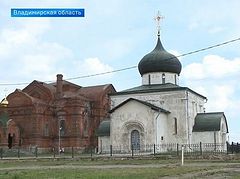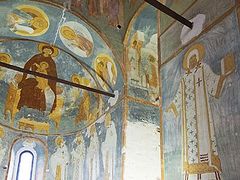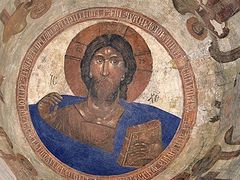Baku, Azerbaijan, July 9, 2019
 Cathedral of St. John the Forerunner. Photo: Wikipedia
Cathedral of St. John the Forerunner. Photo: Wikipedia
Holy monasteries and churches throughout the Orthodox world are honored by their inclusion in the United Nations Educational, Scientific and Cultural Organization (UNESCO)’s World Heritage List, which “seeks to encourage the identification, protection and preservation of cultural and natural heritage around the world considered to be of outstanding value to humanity.”
Now, at its ongoing 43rd session in Baku, Azerbaijan, the World Heritage Committee has resolved to inscribe another 10 Orthodox churches, classified as “Churches of the Pskov School of Architecture,” on the list, reports UNESCO.
According to the D. S. Likhachev Russian Academic-Research Institute of Cultural and Natural Heritage, the churches had a significant impact on the development of architecture in Russia and abroad and include the Cathedral of St. John the Forerunner at St. John’s Monastery, Holy Transfiguration Cathedral at Holy Transfiguration-Mirozhsky Monastery, the Cathedral of the Nativity of the Theotokos at Snetogorsky Monastery, the Church of the Archangel Michael with its bell tower, the Church of the Holy Protection from Proloma, the Church of Sts. Cosmas and Damian on the Bridge, the Church of St. George on the Butte, Theophany Church with its bell tower, the Church of St. Nicholas of the Dried River, and the Church of St. Basil on the Hill.
UNESCO writes of the importance of the churches:
Churches, cathedrals, monasteries, fortification towers and administrative buildings make up the site, a group of monuments located in the historic city of Pskov, on the banks of the Velikaya River in the northwest of Russia. Characteristics of these buildings, produced by the Pskov School of Architecture, include cubic volumes, domes, porches and belfries, with the oldest elements dating back to the 12th century. Churches and cathedrals are integrated into the natural environment through gardens, perimeter walls and fences. Inspired by the Byzantine and Novgorod traditions, the Pskov School of Architecture reached its peak in the 15th and 16th centuries, and was one of the foremost schools in the country. It informed the evolution of Russian architecture over five centuries.
The Committee for the Protection of the Cultural Heritage of the Pskov Region and the Likhachev Institute worked on the nomination since 2015, preparing an updated dossier and site management plan. They also conducted a large-scale study to determine the typological and decorative features of the Pskov architectural school.
 Cathedral of the Nativity of the Theotokos. Photo: Wikipedia
Cathedral of the Nativity of the Theotokos. Photo: Wikipedia
Minister of Culture Vladimir Medinsky spoke about the project in September 2017, saying: “We have all come to the conclusion and I hope that we were able to persuade the heads of the World Heritage Center that it is unfair that Pskov has still not been placed on UNESCO’s list. We will intensify this work. We hope that in a year and a half we will see a UNESCO asterisk next to the city of Pskov on the map.”
“Pskov is one of the cradles of Russia and Russian civilization,” he added at the time.
Preservation work on ancient and unique frescoes in the Cathedral of the Nativity of the Theotokos at the former Nativity of the Theotokos Monastery in Ferapontovo, Vologda Province, a UNESCO site, was recently completed after 40 years of work.
Follow us on Facebook!



